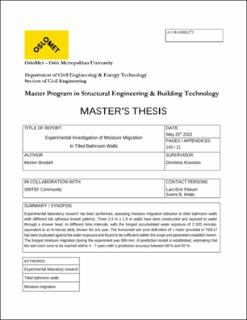| dc.description.abstract | Moisture related damage to buildings are a continuously increasing trend regarding both occurrences and indemnity cost. More and more knowledge is available in the industry; however, the negative trend continues. This master's thesis is a contribution to turn the trend, providing insight into moisture migration in the grout and tile adhesives in tiled bathroom walls.
Several research questions and hypotheses are established, challenged, and answered. The main objective of this experiment is to observe and assess moisture migration behavior in cementitious tile adhesive and grout, when tiled walls are exposed to a range of water cycles using a commercial shower head. This is done to evaluate if the wet zone definition in TEK 17 provides sufficient moisture safety in dwelling bathrooms. The research is performed in an experimental laboratory setting with emphasize on a realistic setup, providing a visual presentation and assessment of moisture migration, supported by data acquisition including weight-, temperature-, water flow rate- and relative humidity measurements.
Three 2.4 m x 1.8 m walls comprising lightweight wooden framework, mounted with 30 mm wet room boards with RH-sensors attached, have been constructed. The walls are clad with a mix of 150 mm x 150 mm glass- and ceramic tiles in an approx. 9: 10 ratio. Cementitious tile adhesive and grout are used to install the tiles, with emphasis on leaving trowel groove patterns in two orientations in the tile adhesive, both horizontal and curved. A sorption experiment on four different tile adhesives are performed, contributing with parameter input to the main experiment.
Moisture migrates differently in the two types of tile adhesive trowel patterns, where the furthest moisture migration occurred in curved trowel pattern. After 2 920 minutes of water exposure, distributed in different exposure increments, equivalent to a daily 8-minute shower for 365 days, there was measured a fully saturated area of 1.68 m2, with the furthest horizontal moisture migration being 899 mm. The water exposure is concentrated on one specific point during the whole experiment. This concludes that a tiled bathroom wall, applied with cementitious tile adhesive and grout behaves like a sponge, yet the defined wet zone is not reached by moisture within the scope of this experiment.
Prediction models for future moisture migration has been developed, estimating that the 1-meter wet zone will to be reached by moisture after 4 -7 years incl. prediction accuracies between 89 % and 92 %. | en_US |
